
Estate Museum
in Izvara
 |
Nicholas Roerich Estate Museum in Izvara |
The Roerich Pact
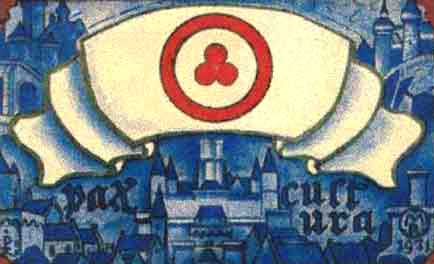
N. K. Roerich "Pax Cultura. (Banner of Peace)", 1931
|
PROTECTION OF ARTISTIC TREATY
BETWEEN THE UNITED STATES OF AMERICA AND THE OTHER AMERICAN REPUBLICS The High Contracting Parties, animated by the purpose of giving conventional form to the postulates of the Resolution approved on December 16, 1933, by all the States represented at the Seventh International Conference of American States, held at Montevideo, which recommended to the Governments of America which have not yet done so that they sign the 'Roerich Pact', initiated by the Roerich Museum in the United States, and which has as its object, the universal adoption of a flag, already designed and generally known, in order thereby to preserve in any time of danger all nationally and privately owned immovable monuments which form the cultural treasure of peoples", have resolved to conclude a treaty with that end in view, and to the effect that the treasures of culture be respected and protected in time of war and in peace, have agreed upon the following articles. |
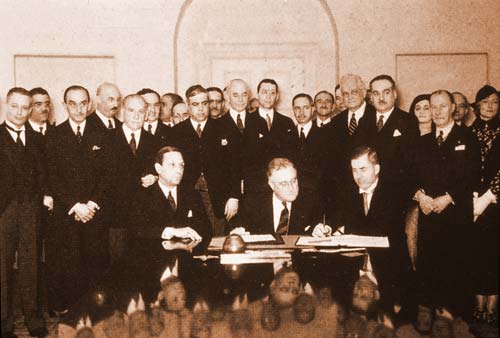
The signing of the Roerich Pact by the leaders of twenty countries of Latin America and the USA.
Washington, The White House, 15 April 1935
|
ARTICLE I The historic monuments, museums, scientific, artistic, educational and cultural institutions shall be considered as neutral and as such respected and protected by belligerents. The same respect and protection shall be due to the personnel of the institutions mentioned above. The same respect and protection shall be accorded to the historic monuments, museums, scientific, artistic, educational and cultural institutions in time of peace as well as in war. ARTICLE II The neutrality of, and protection and respect due to, the monuments and institutions mentioned in the preceding article, shall be recognized in the entire expanse of territories subject to the sovereignty of each of the signatory and acceding States, without any discrimination as to the State allegiance of said monuments and institutions. The respective Governments agree to adopt the measures of internal legislation necessary to insure said protection and respect. ARTICLE III In order to identify the monuments and institutions mentioned in article I, use may be made of a distinctive flag (red circle with a triple red sphere in the circle on a white background) in accordance with the model attached to this treaty. ARTICLE IV The signatory Governments and those which accede to this treaty, shall send to the Pan American Union, at the time of signature or accession, or at any time thereafter, a list of the monuments and institutions for which they desire the protection agreed to in this treaty. The Pan American Union, when notifying the Governments of signatures or accessions, shall also send the list of monuments and institutions mentioned in this article, and shall inform the other Governments of any changes in said list. ARTICLE V The monuments and institutions mentioned in article I shall cease to enjoy the privileges recognized in the present treaty in case they are made use of for military purposes. ARTICLE VI The States which do not sign the present treaty on the date it is opened for signature, may sign or adhere to it at any time. ARTICLE VII The instruments of accession, as well as those of ratification and denunciation of the present treaty, shall be deposited with the Pan American Union, which shall communicate notice of the act of deposit to the other signatory or acceding States. ARTICLE VIII The present treaty may be denounced at any time by any of the signatory or acceding States, and the denunciation shall go into effect three months after notice of it has been given to the other signatory or acceding States. IN WITNESS WHEREOF, the Undersigned Plenipotentiaries, after having deposited their full powers found to be in due and proper form, sign this treaty on behalf of their respective governments, and affix thereto their seals, on the dates appearing opposite their signatures.
|
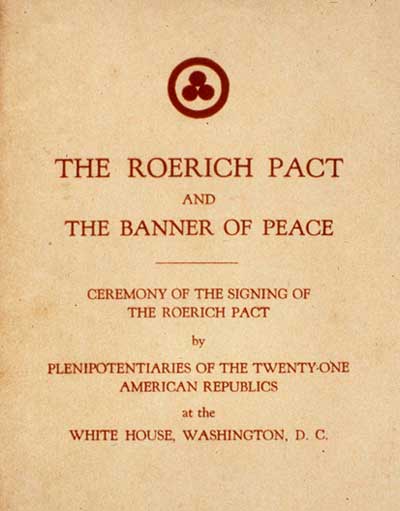
The title page of the booklet about the signing of The Roerich Pact.
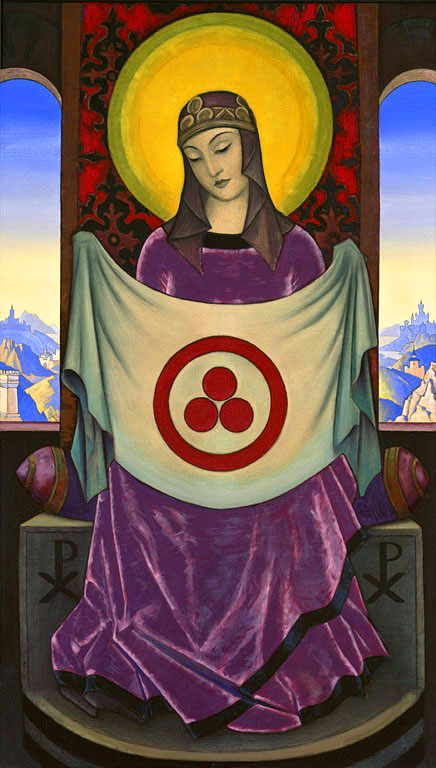
N. K. Roerich "Madonna Oriflamma", 1932
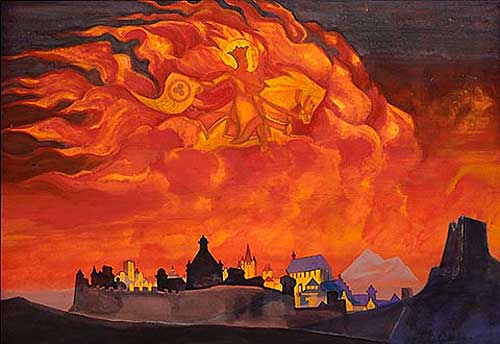
N. K. Roerich "Sophia—the Wisdom of the Almighty", 1932
|
70th Anniversary of N. Rerikh Pact on
N.K. Roerich The idea of making a special agreement about protection of cultural heritage in the time of war was put forward by N.K. Rerikh in 1904-1905, during the Russian-Japanese War, at one of the sittings of the Russian Architectural Society. Predicting the horrors of the World War I the Artist made a series of pictures which served as a warning to the mankind. They are “The Sword of Valor” (1912), “Cry of the Serpent” (1913), “Fire” (1913), “The Condemned Town” (1914). In 1929 N.K. Rerikh appealed to the peoples and governments of all the countries with a draft of the Pact. It pretended to be an international legal act of universal importance. The Pact with its approved symbol Banner of Peace “could be use not only during the war but in “every day life, when without thunder of guns some harsh and uncorrectable mistakes are made against Culture”. According to the artist’s idea the Banner of Peace must be raised above all cultural monuments, museums and scientific institutions. Its identification signs are a white cloth and three red circles in the centre of it. They should mean Future, Present and Past surrounded with a circle of the eternity. In 1930s a wide public movement of adepts of the Pact began. In some countries the K.Rerikh’s Pact societies were formed. In 1931-1932 in signing of the Rerikh Pact took place. It was on the 15th of April, 1935 in Washington, in the White House by the representatives of 21 states of the American continent. Despite the fact that the N. Rerikh’s idea was not fully realized in those years, now it is necessary to stress a large political and social effect of the Pact and its role in struggle for peace, cultural understanding and cooperation of nations. In support of the Pact such outstanding people as Franklin Roosevelt, Romen Rolland, Robindranat Tagor, Herbert Wales and Albert Einstein stood out. A large public movement was developed in three Baltic States – Latvia, Lithuania and Estonia in 1930s by the Rerikh’s societies of those countries. With the help of R. Gudzitis dozens of best cultural workers, public figures, politicians and military servants signed the public appeal in support of the Pact. The question was even discussed at the conference of ministers of foreign affaires of three countries. But under the pressure of some European countries which were preparing for a new division of the world the Pact was not signed. During the post war period an Italian association of the Rerikh Pact in Bologna was the most active. In 1946 the Pact was supported by the All-Indian Conference of Cultural Unity, and in 1948 it was adopted by the government of India headed by D. Neru. Unfortunately the documents stating the fact were not sent to the Committee on the Rerikh Pact. And only in 1950 the Rerikh pact Committee adopted all documentation beginning from 1930. In 1954 the famous Hague Convention about Protection of Cultural Property in the Event of Armed Conflict was adopted. It was based on the ideas of Rerikh Pact, but the symbol of Banner of Peace was substituted for another one under the pretext of being too complex to draw in at war. It should be also mentioned that the Rerikh Pact protects cultural values not only in days of war, but in time of peace as well. Unfortunately the mankind lacks the detailed analysis of both losses. In 2003 before the Iraq crises an international group of workers of culture was formed. It included public figures and lowers from Russia, India, Latvia, Lithuania, Estonia and Hungary. The group was aimed to learn the opportunity of promoting the Rerikh Pact in everyday life. We think that at present we must face the Pact once more because a number of international legal documents in the sphere of culture do not work. Meanwhile the Rerikh Pact proves to be quite simple from legal point of view and it is still in valid because it was never denounced. It may serve as an orienteer to direct a public thought to. What shell we do for that? To begin with a special group of legal experts should legally estimate the situation on four agreements (Washington – 1935; Hague – 1954; Paris – 1970 and 1972). There is a reason to begin with the countries that signed the Pan-American Treaty. This question may be raised by the leader of a state in any suitable moment implying a certain degree of readiness of the world cultural, political and public circles. A situation with the Latvian intelligentsia which kept silent for a long time was remarkable from some point of view. In our opinion the Pact should be not only a historic and symbolic document. It should be a working paper which may promote prevention of crises of humanism. Mass media did a lot for drawing the public attention to losses of cultural property in war conflict in Iraq. It is a good moment to direct the public thought to the Pact of Peace and the Banner of Peace. We believe it is necessary to establish the Banner of Peace symbol for all the international treaties aimed to protect culture (here we mean to substitute the sign of the Banner of Peace for the one adopted by the Hague Convention of 1954). In this article we tried to use the experience of three Baltic States of 1937 when the question provoked by cultural public was solved on the level of foreign minister of the republics. At one of the universities in Budapest an independent legal investigation was held to study the situation with international agreements in the sphere of protection of cultural heritage which do not work. In the course of investigation we found out that Iraq registered only one cultural property lost, so nobody got to know how things really were. Now I am going to let you know what work based on international communication has been done and conclusions were made of it.
The main conclusions after a study of the public opinion are as follows:
Representative of the international public movement |
| Back |